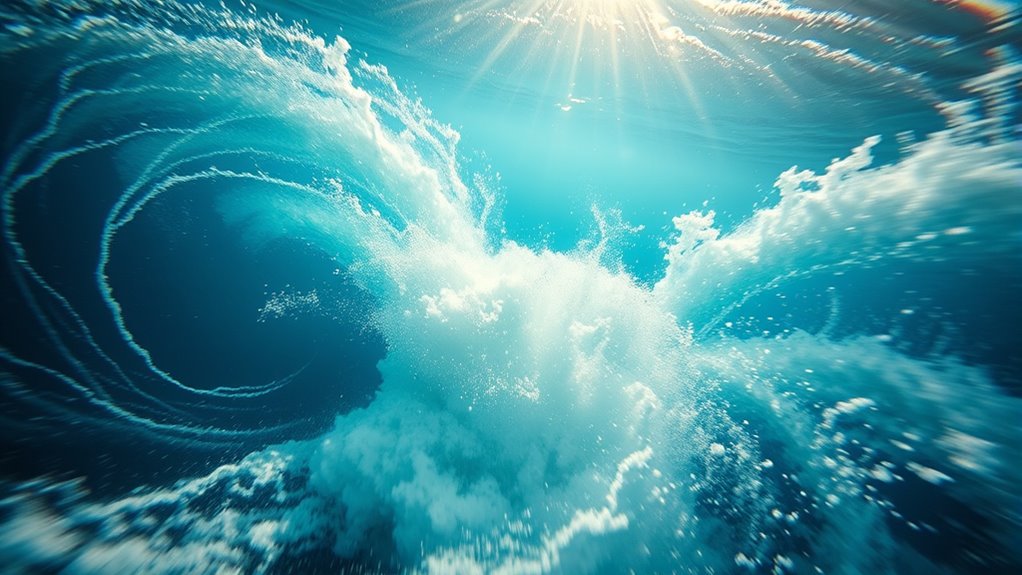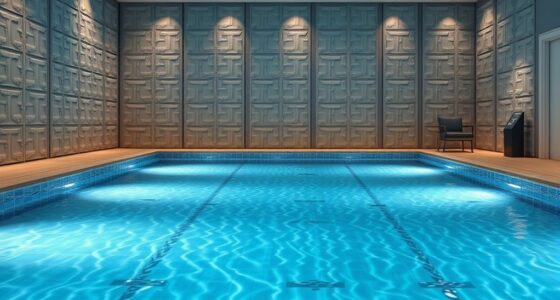Swim currents are created by natural forces like wind, temperature differences, and Earth’s rotation, which influence water movement. Engineered systems like propellers work by rotating blades to push water backward, generating thrust and currents, while jets accelerate water through nozzles to produce high-speed flows. Both methods use hydrodynamic principles, but they do so differently. If you keep exploring, you’ll discover how these systems harness water dynamics to create and control currents effectively.
Key Takeaways
- Propellers generate currents by rotating blades that push water backward, creating thrust and flow in specific directions.
- Jets produce high-speed water streams by accelerating water through nozzles, generating powerful currents.
- Propellers typically create broader, slower currents, while jets produce focused, high-velocity flows.
- Both systems rely on hydrodynamic forces: propellers use blade movement, jets use fluid acceleration.
- The choice between propellers and jets influences the strength, direction, and application of the resulting swim currents.

Swim currents are created by the movement of water caused by natural forces like wind, temperature differences, and the Earth’s rotation. These forces generate flows that can influence your swimming experience, whether you’re in open water or a controlled environment. Understanding how these currents form involves exploring how hydrodynamic forces interact with aquatic propulsion methods, which are used both naturally and artificially to move water.
Hydrodynamic forces play a pivotal role in shaping swim currents. They involve the interactions between water and objects, including your body or engineered devices like propellers and jets. When wind blows across the surface, it transfers energy to the water, creating ripples and larger currents. Temperature differences cause water layers to move as warmer, less dense water rises and cooler, denser water sinks, setting up convection currents. Earth’s rotation also influences large-scale water movements through a phenomenon called the Coriolis effect, subtly steering currents and affecting their paths.
Hydrodynamic forces shape swim currents through interactions with water, influenced by wind, temperature, and Earth’s rotation.
In the natural environment, aquatic propulsion is a key factor in how currents are generated and sustained. For example, schools of fish and marine mammals use their muscles to generate movement that displaces water. This muscular effort creates local currents that can ripple outward, contributing to the broader flow of water. These creatures harness hydrodynamic forces efficiently, converting their muscular energy into movement that influences their surroundings. Their swimming creates a series of small-scale currents that, collectively, can alter local water patterns.
When it comes to artificial systems, aquatic propulsion methods like propellers and jets mimic these natural processes but are designed for efficiency and control. Propellers work by rotating blades that push water backward, utilizing hydrodynamic principles to generate thrust. This thrust moves water, which in turn produces currents that can be directed or subdued depending on the design. Jets, on the other hand, accelerate water through a nozzle, creating a high-speed flow that generates a jet current. These systems rely heavily on hydrodynamic forces, manipulating water flow to achieve desired movement. By understanding how these forces interact with propulsion methods, engineers can optimize water movement for various applications, from submersibles to recreational pools.
In essence, whether driven by natural forces or engineered devices, the creation of swim currents hinges on the interplay of hydrodynamic forces and aquatic propulsion. You experience these currents constantly, shaped by the complex physics of water movement. Recognizing this relationship helps you appreciate how currents are generated and how they can be controlled or predicted, whether you’re swimming in the ocean or operating a watercraft. Moreover, advancements in propulsion technology continue to improve our ability to manage and utilize these currents effectively.
Frequently Asked Questions
How Do Different Boat Sizes Affect Current Strength?
Your boat size directly impacts current strength; larger boats tend to generate stronger currents because they displace more water and have more powerful propulsion systems. Smaller boats create less water disturbance, resulting in milder currents. When considering the current impact, bigger vessels can influence the environment more profoundly, affecting nearby swimmers or other boats. So, always account for your boat size to understand its potential influence on the surrounding water flow.
Can Swim Currents Change Direction Unexpectedly?
Yes, swim currents can change direction unexpectedly due to hydrodynamic shifts caused by boat movements, wind, or changes in water depth. As a swimmer, you should stay alert and maintain awareness of your surroundings. Sudden shifts in current direction can catch you off guard, so it’s essential to observe water patterns and adapt your strokes accordingly to stay safe and conserve energy.
What Safety Measures Exist Around Strong Swim Currents?
Imagine swimming in a river with hazard signs warning of strong currents—you’ll want to stay alert. Safety measures include clear rescue techniques and visible hazard signs to warn swimmers. Lifeguards are trained to recognize and respond to dangerous currents quickly, using rescue techniques like reaching or throwing aids. Always heed hazard signs, stay within designated swimming areas, and avoid strong currents unless you’re experienced and supervised.
How Do Environmental Factors Influence Current Formation?
Environmental factors like tide influence and wind patterns considerably shape current formation. You’ll notice that high tides can create stronger currents as water moves to equalize levels, while low tides often weaken them. Wind patterns also push surface waters, generating or intensifying currents in specific directions. By understanding these factors, you can better anticipate current behavior and stay safe while swimming or boating in affected areas.
Are There Natural Swim Currents That Compare to Man-Made Ones?
Yes, natural flows like oceanic streams and currents are similar to man-made ones. You can observe them in the ocean, where large-scale movements like the Gulf Stream create powerful, steady flows. These natural currents are driven by factors like wind, Earth’s rotation, and temperature differences. Just like artificial swim currents, they influence how water moves, helping you navigate and understand the ocean’s dynamic environment.
Conclusion
So, whether you’re marveling at the mighty propellers or the sleek jets, remember—nature’s swim currents don’t need a motor. They just happen, reminding us that sometimes, the best way to go with the flow is to stop fighting it. Maybe next time you feel stuck, you’ll realize it’s not about how you move, but about choosing whether to be the force or just ride the wave. After all, who needs engines when you’ve got the ocean’s own mood swings?










